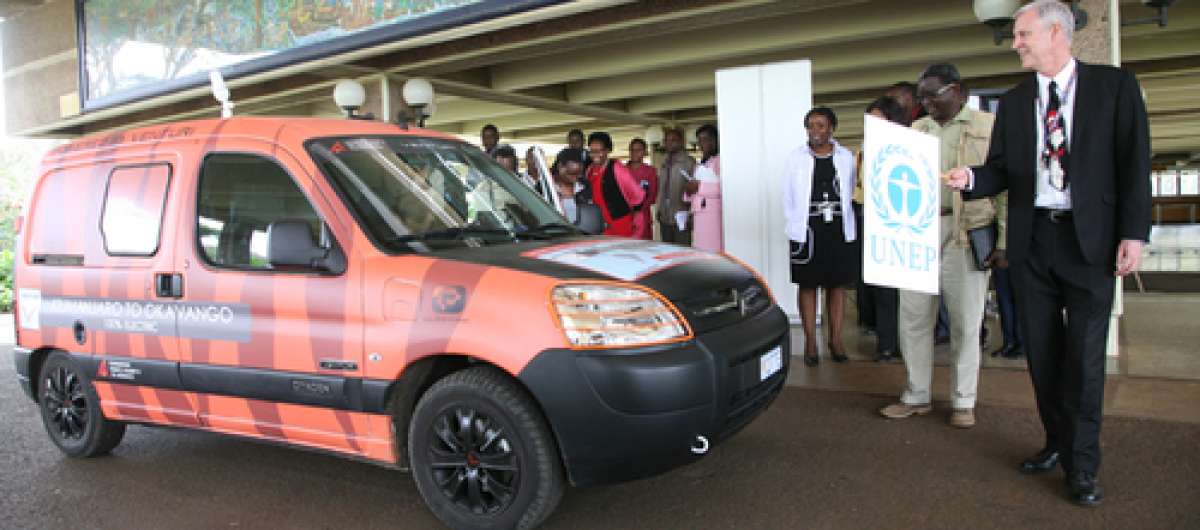Africa is, to some, a land of adventure, and Xavier Chevrin has set off on what should be an amazing one. Driving an an electric Citroën Berlingo, he left the UNEP's offices in Nairobi Kenya the other day. The Berlingo, which is normally used by the French post office as a delivery van, was modified by Venturi to have 300 mile driving range. He is driving alone on a trip from Nairobi to Johannesburg South Africa, solely on electric power, with no technical assistance or reconnoitering, no portable generator, driving across a continent known for unreliable electricity supplies.
Chevrin is not a stranger to long range electric vehicle trips. He claims that his 2010 trip from Shangai to Paris was the longest journey ever made in an electric vehicle. We can think of other long-range electric vehicle trips such as the 2010 around the world trip by Nina Rasmussen and Hjalte Tin in an electric car, but they carried a portable generator on their trip, while Xavier Chevrin does not. Chevrin certainly gets extra bravery points for making a long range trek without the backup generator one would think to be required in the places in Africa where electricity is hard to find. It turns out, though, that the inadequate electrical supply in Africa is one of the points to be demonstrated by the trip.
The trip is part of Mission Africa, which itself is part of the UN International Year of Sustainable Energy for All. The goal of the trip is to demonstrate the "reliability and energy efficiency of electric vehicles under extreme conditions" while at the same time highlighting the lack of electricity in many communities in Africa. The trip is also receiving support from the Prince Albert II of Monaco Foundation.
The route will take Chevrin through the bush of Kenya, Tanzania, Zambia, Zimbabwe, Botswana and South Africa, cover a total distance of 4,800 kilometers (2,982 miles) and require one-and-a-half months.
"We have been using combustion engines for over a century, but now it is a new revolution," Mr. Chevrin said. "Within a few decades it will be logical for everyone to have an electric car as it fits with the philosophy of having to be careful how we use energy."
Chevrin says his Shanghai to Paris trip demonstrated that electric vehicles could be completely zero emission, more energy and money efficient, and expects the trip across Africa will do the same. The Shanghai to Paris trip consumed less than $200 dollars in electricity while it's estimated it would have required $4,000 worth of diesel. The Africa trip is timed to coincide with the season in which Africa's electricity is mostly hydro-electric, a renewable and zero-emissions source of electricity.
"We want to prove that electricity is an alternative energy source that can be used for transportation," Chevrin said.
During the trip he plans to trust on locals for recharging the battery pack in the Berlingo van. While this sounds risky, he plans to use these encounters with locals to spread awareness of clean technology choices they could be making. He does run the risk of getting stranded, no backup generator, potentially far from any village or the electricity grid. This is the sort of consideration which adds "to the scale of the adventure," but is also a deliberate choice to "prove the reliability, robustness and endurance of Venturi electric cars."
The vehicle, a Citroën Berlingo, normally sees service in the French postal department as a delivery vehicle. The electric drive train built by Venturi has a 70 kilowatt-hour battery pack of Nickel Sodium Chloride batteries, and a 42 kilowatt Three Phase Asynchronous Motor capable of 180 Nm of torque. Recharge time is said to be 5 hours at 220 volts 16 amps. The electric Berlingo in use by the French postal authorities has one battery, and Chevrin's has three, hence the 70 kWh capacity. The supersized battery pack gives a longer total driving range of 310 miles, and the top speed is around 70 miles/hr.
Long range trips like this in an electric car are one of the ways to demonstrate electric vehicles can take over all aspects of our car culture. Building a long range electric car is simply a matter of building in a large battery pack. For example Tesla Motors claims the Model S sedan, with its 85 kilowatt-hour battery pack, will give over 300 miles total driving range. However these large battery packs come at a cost, and today for an electric car to have any figment of affordability, the battery pack has to be fairly small, giving a fairly short driving range. In the due course of time battery pack costs will drop, and long range trips like Chevrin's will stop being a newsworthy novelty, and become every day commonplace.
You can follow the Mission Africa trip at their website: http://english.missionafrica.fr/





